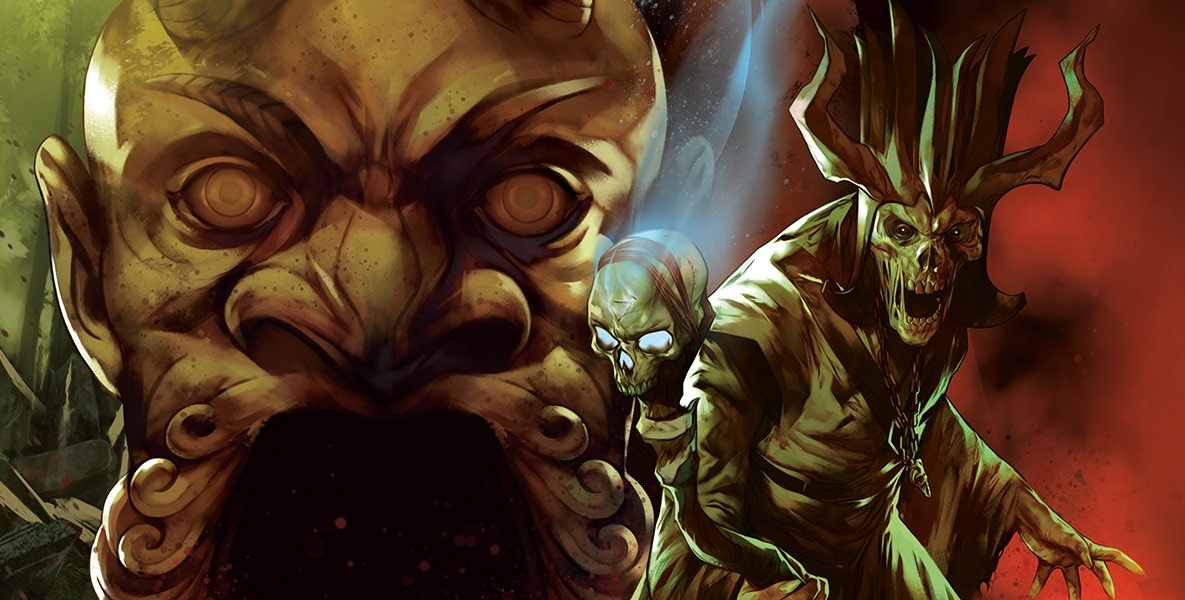
Tomb of Annihilation Review and Modifications (Part 1)
Spoiler Warning: This review will have major spoilers for Chapters 1 and 2 of Tomb of Annihilation.
I’m excited to say I am a whole year and 21 sessions into running Tomb of Annihilation (TOA) on Roll20 with some good friends. We are in the middle of a golden age of tabletop role-playing games brought forth by a few things:
- nostalgia-inducing Fifth edition of D&D
- streaming & podcast driven exposure of the hobby
- something about the times we live making games that require eye contact with your friends exciting
This is a review of the published adventure “Tomb of Annihilation” of the main Wizards of the Coast D&D brand, which I decided to use as the basis for my game. If you are looking for a breakdown of the adventure, check out other reviews first.
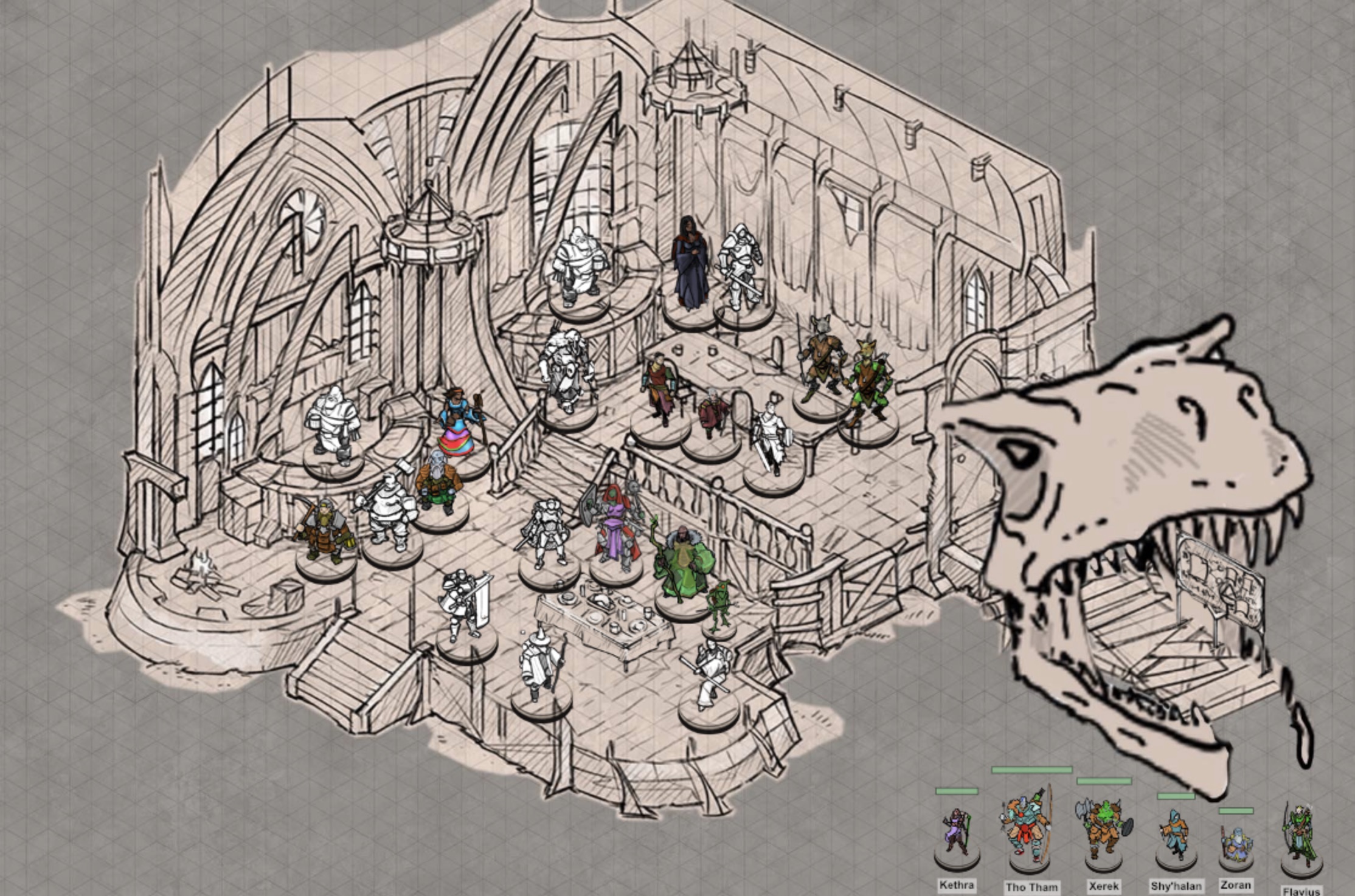
Game 6: Thundering Lizard tavern with full isometric art from Epic Isometric. Lots of token customization.
If you’ve come interested in my isometric conversion of the module, check out my previous post on the subject last year. The two most important tips are that you can convert top-down maps to isometric with a two-step transformation in a picture editor and that you should check out Epic Isometric as a way to introduce a consistent visual style to your game. As it’s a derivative work of art and game assets from all over, I’ll just say I made it intended for personal use. I encourage folks to support the hobby by buying art packs from artists like Mike Schley and Epic Isometric. The Roll20 and DndBeyond content packs for Tomb of Annihilation are both awesome.
TL/DR my take upfront
This is my favorite published adventure so far in 5th edition. It has its weaknesses, but the immersive setting and high adventure combined with easy customization make for a fun time for many varieties of gaming groups. Read below for my pros, cons, and modifications for my table.
Pro: Why I love this adventure
A series of non-linear sandboxes
The game is divided up into 5 chapters each representing a different non-linear section of the story. Chapter 1 focuses on a port city that can be explored in any order. Chapter 2 is a large jungle map with dozens of sittings worth of content to explore. Chapter 3 switches into a similar non-linear exploration of lost ruin with multiple factions racing to solve … well, I’m not there yet in my game so we’ll keep the spoilers to the first two chapters.
Nostalgia with flexibility
TOA is an homage to 1st edition D&D, right down to its close namesake the Tomb of Horrors, hexcrawl style open-world exploration, and expectation of high player death. There is even an optional rule for a “Meat Grinder” difficulty setting. All of this tickles the current nostalgic desire for old school revival in RPGs without locking GMs out of any innovations or story-driven possibilities of more modern games.
This module is still flexible enough to suit most styles of play. Surveys of dozens of games in Facebook groups of GMs running show a high variance of actual player death, which I see as a victory of flexibility to the preferred style of play for different groups. I’ve been able to pick and choose ideas from these online communities of GMs running the module and mix them in easily to the broad sandbox-style without disrupting or distracting the flow of the game.
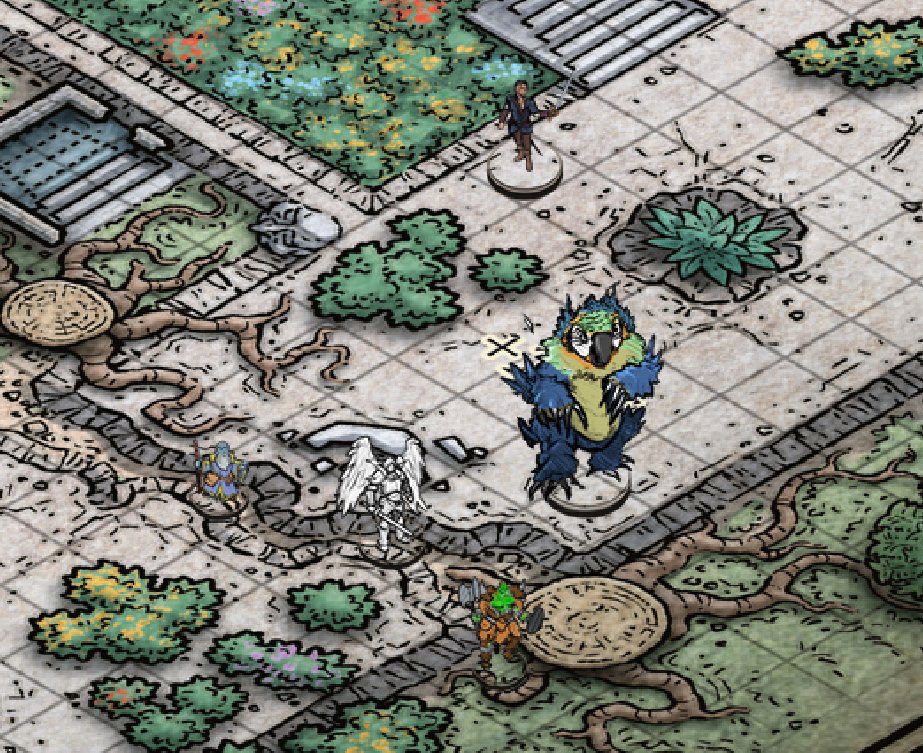
Game 21: Fighting a Macawbear in Nangalore
Here are a few great ideas inspired/taken from others (some sources hard to direct link to)
- The dreaded Macawbear (it’s an owl bear with macaw plumage)
- The Aldani rap battle: From the great GMs Facebook community: the lobster people of the Aldani basin only speak or negotiate in rhyming poetry duels
- Skeleton outpost: from Adam Kobel’s (not sure where he got it) Roll20 Presents stream, an outpost of undead soldiers who don’t know they are undead.
- The Library of Kir Sabal: from Reddit, the contents of Asharra’s library
It has a great ‘destination’ setting
The land of Chult is a peninsula south-west of the original “Sword Coast” location of Ed Greenwood Forgotten Realms setting. Forgotten Realms is often called “Kitchen Sink Fantasy,” as it makes a place for every possible morsel of D&D content and high magic fantasy trope rather than doing fewer things and doing them well. I remember when I was hesitant to run a game in the mid-‘90s because I thought the 10-year-old setting had too much lore. Twenty years later and that has only gotten worse. The risk of having too much setting back story is that the focus of the game can quickly become about the setting and the NPCs rather than the players themselves and the adventures they are having, especially when some of the players have read the books or played the video games that share the world of the adventure module.
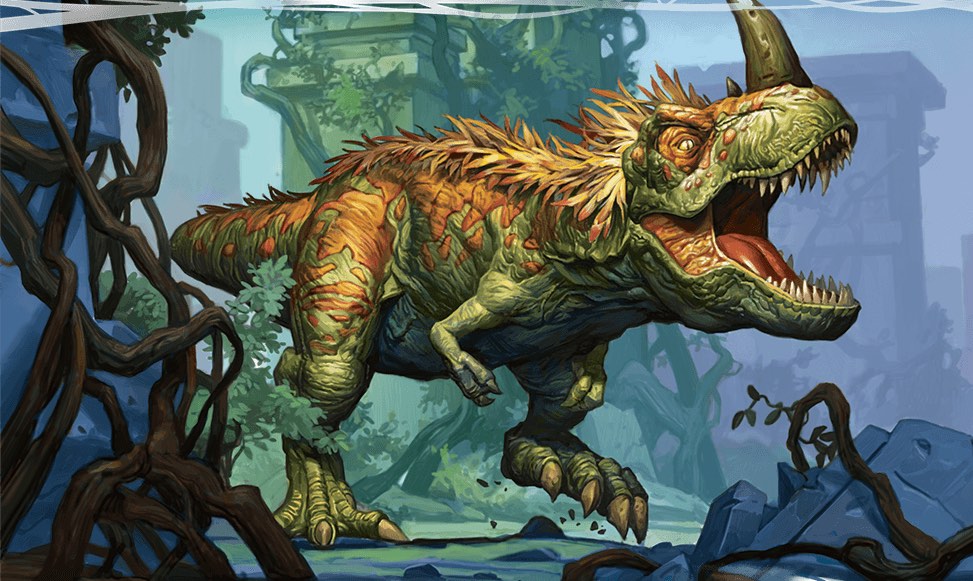
Dinosaur Island is a great pulp setting
By having the entire adventure take place in the Dinosaur and Zombie infested peninsula of Chult, players are removed from their preconceptions of standard Tolkien-ish medieval or proto-renaissance social structures without having to grapple with anything too disorienting. Chult is a high theme setting, backing up style with substance (Dinosaurs everywhere!). While part of the Forgotten Realms, Chult is a richer and more exciting setting than I’m used to from D&D adventure modules since the heyday of the 2nd edition setting explosion.
The encounters are genuinely creative and funny
Less time in TOA is spent exploring thirty room dungeons with little interesting per room and more time is spent on showpiece destinations in the jungle that can be completed in a single night. On top of that, some of the encounters are comic gold. As and example: scaling the jungle pyramid Orolunga has a hilarious skill challenge (remember those?) that encourages acting on the part of the players and is all but guaranteed to break the table into uncontrollable laughter. As another example, Firefinger is a grand vertically stacked dungeon and truly fun to explore. The set-piece battle against the Pterafolk (evil humanoid pterodactyls) high above the jungle carries the real risk of PCS being thrown hundreds of feet below to their deaths. Many such set-piece battles in fun locations are the kinds of things players remember.
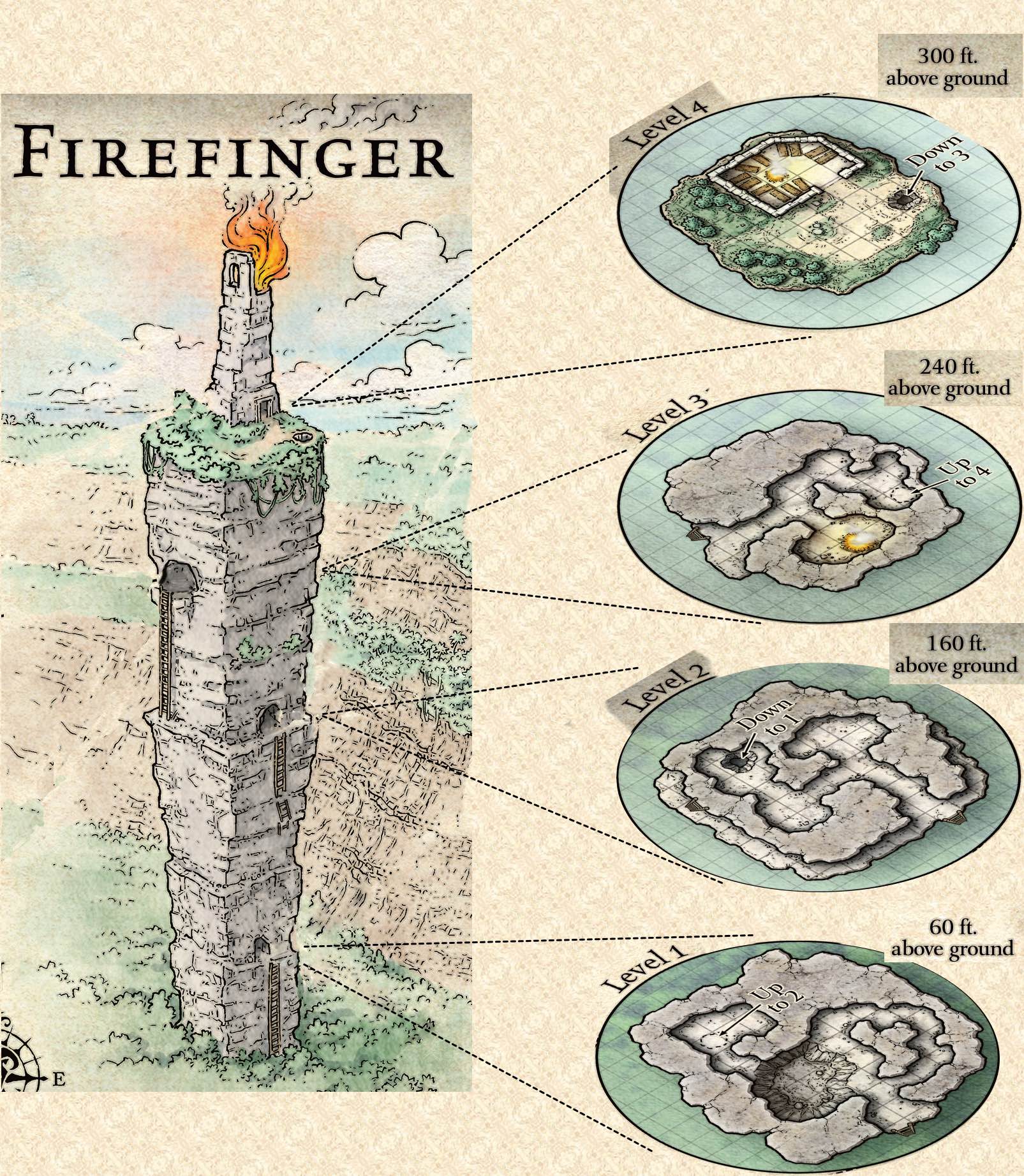
Game 5: Firefinger converted to isometric
Con: Weak points of the adventure
Some of these are real weaknesses. Making a published adventure is always difficult as it has to sell to the broad spectrum of gamers and account for every possible play style and character back story. These are my criticism, read below to see how I adapted the first year of my TOA game to adjust.
Like most published modules it has a weak start
The hardest thing for a published adventure is to make a captivating start that will appeal to all possible permutations of groups and character motivations. TOA starts with exposition about the death curse and an infected quest giver followed shortly by teleportation to the only remaining civilized outpost in Chult. The game introduces a somewhat empathetic character and the ticking clock of her demise to encourage forward motion in the story. It works, but I highly recommend having the players tie their character backgrounds more firmly in self-written plot hooks to explain why they would dare risk it all on this quest.
It’s a mystery without good clues
The first two chapters are set up as an exploration and mystery, where the PCs have to discover the source of an evil Curse knowing only that the answer lies somewhere in Chult. They have to first discover that the answer to the mystery lies in the lost city of Omu and then discover the location of Omu. The NPCs and quest givers push the players towards locations and scenarios where the players can uncover more exposition that just tells them the answers to the above two questions. Diagramming the actual solution shows how expository and flimsy mystery adventures can be in D&D. There are very few links and missing a search role is all it takes for a month’s worth of exploring to miss an important ‘clue’.
I highly recommend GMs read a Gumshoe based RPG book like Trail of Cthulhu to get ideas on how to improve the narrative flow of mystery adventures in RPGs. Finding important clues that form the critical path have to be automatic if the players follow the trail of clues. Interpreting the clues should be the challenge instead of the rolls. Rolling well should expose extra information that enriches the story and immersion, giving payers extra info that will help them stay alive on the next leg of the trail of clues. The trail should be non-linear, with multiple possible paths and enough loose hooks to help a GM improvise paths mid-game. I’ll detail how I planned my Chapter 1 and Chapter 2 mystery path.
Too many NPCs in combat
Much like Out of the Abyss, players in TOA have the opportunity to meet many NPCs who are willing to join the party and take part in battles. The problem is that every additional NPC and balancing extra monster adds more action economy and characters into the initiative role. 4 players 4 monsters taking 1 minute each to resolve combat actions takes 40 minutes to finish a 5 round combat. A 4 player group with 2 NPCs in tow, facing a slightly harder group of more numerous and tougher monsters (let’s say it’s 5 monsters) now takes 55 minutes to resolve the same fight. Some of the NPCs are well written, adding flavor and context to the world. Others are D&D lore fan service, cameos pulled straight out of a different D&D product. If a GM isn’t careful, the spotlight can quickly fall on these NPCs who are powerful enough to become the dreaded GM-PC.
Is Chult post-Colonial Africa?
This is worth a read as it is a much better writeup of issues some have with TOA with regards to depictions of race and colonialism in Chult this Kotaku article
A game of make-believe for both children and adults, I’d encourage GMs to have open communication with their players on the topic and to adjust, remove, or emphasize the parts of the module that make it more fun or interesting to them. I am glad I saw the above article before playing and I made a few adjustments.
My Modifications
Altering Chult
To distance the setting even further from the Forgotten Realms, I changed Chult to be a large island more remote from the “mainland” where the players who are “outlanders” come from. The locals call the island “Chult” but in the prelude, I made it clear that everyone on the mainland still refers to it as “Dinosaur Island” and there is very little common knowledge of its history.

Game 6: The view from Firefinger. Don't worry about how many miles you can see to the horizon, this is D&D
I downplayed Artus Cimber, who I saw as a show-stealing NPC that did little to move the story forward given my players have not read previous books or played in previous modules to which he is connected.
I emphasized the power, wealth, and political nature of the Merchant Princes, who were mostly revolutionaries against the recent colonial rule of Chult. Given that Chult lost its patron deity, Chultans are open and welcoming of religious workship that doesn’t challenge their mercantile dominance of Chult’s vast mineral wealth. I set up a side story where the Flaming Fist and the Merchant Princes’ relationship would dissolve throughout the adventure. The Princes are not sell-outs, they are patriots. The Merchant Princes’ weakness is their general lack of interest in the history of their Island, which puts them at odds with other factions.
Red Wizards are cool and very connected to the main story mystery, so I kept those. Zentarim and Harpers seemed like a Lore driven fan-service side quest, so I wasn’t interested.
Chult is massive, so I slowly established that the old Omuan empire once had numerous cities across the island, most of which lay in ruins, and a large population of peasants living quite happily in the jungle. Why have all these chasm bridges if they lead nowhere? Mezro was a sister city and the original home of Ras Nsi. It is destroyed rather than any other Lore driven subplot. Spell Plagues have nothing to do with this adventure, why complicated things? Mbala is the most recent Omuan settlement to fall. Orolunga, on the other hand, I changed to be a city that defies time. Orolunga is a city built around an ancient ziggurat of pre-Omuan culture that will not be founded for a few hundred more years. The Sage of Orolunga is a diviner who lives in the future but can project herself into the past, which is how she knows things. She knows her present (the future) is doomed if no adventurers stop the death curse so she is very willing to help them out, but has to stay cryptic so she doesn’t’ interfere too much in history. That last one might be a bit of GM-head-cannon, but who cares.
Alternate Start: Shipwreck!
I started the game by explaining how impactful the death curse has been on society and that the game starts on a crowded boat to Port Nyanzaru. When I asked my players what they were excited for they indicated they wanted to explore and adventure in addition to the death curse plot so I removed the ticking clock aspect of the connection to Syndra Silvane.
The players each explain why their character is headed to Dinosaur Island to investigate the death curse. They all need to provide a good reason to keep the story moving forward. Also on the boat are dozens of other “outlanders” who will be investigating the island and can be a source of recognizable replacement characters to help quickly rationalize additions to the party encountered hundreds of miles into the jungle. The party also finds the boat is transporting red wizards, who keep to themselves.
The first real encounter, happening only a few minutes after character introductions is a “story mode” encounter (a video game term meaning it is purposely on rails) with Aremag the dragon turtle. Aremag is goaded on by his kobold worshipers onshore. The boat is destroyed, shipwrecking the players 20 miles from the port. The players wash up on a beach outside a Kobold cave.
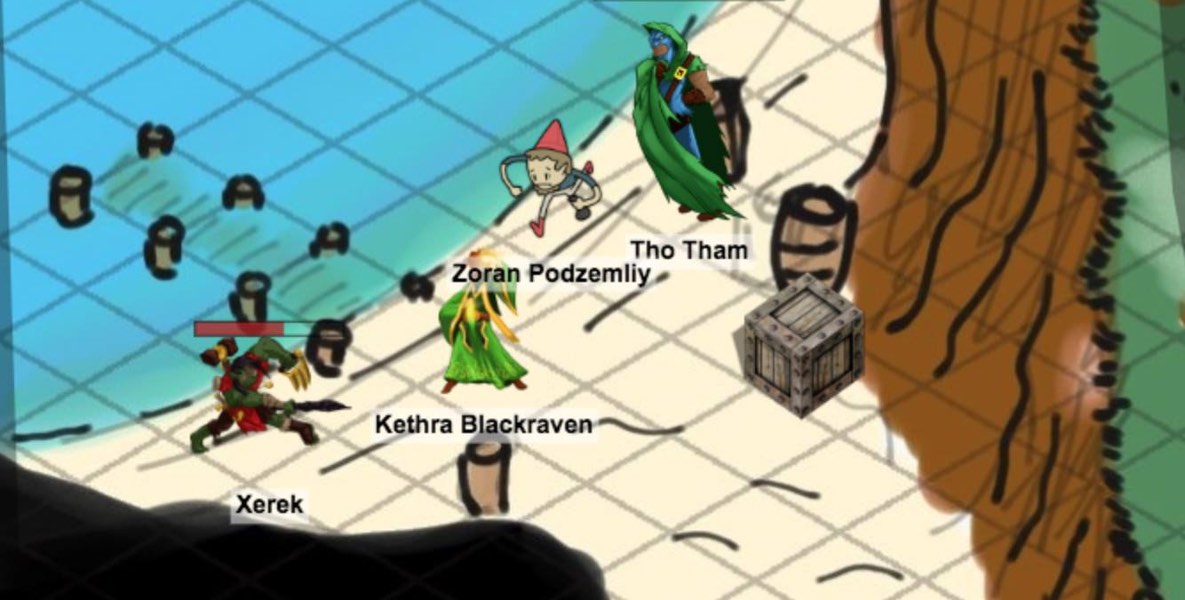
Game 1: A shipwreck start. At this point I was still working on the art style of the game.
Faced with a survival situation and all their supplies other than essential armor and weapons stripped from them the PCs must band together (and learn the darn rules) to survive. With no equipment, the PCs must then survive a two day walk to the port and get a rough but short introduction to the hexcrawl in Chapter 2. Given that they have zero money, the PCs will then need to take some jobs in port to have enough money to outfit an expedition into the jungle.
Pacing in the Jungle Grind
The random encounters for Chult’s jungle are a lot of fun as long as you don’t let it turn into a repetitive grind. If your players enjoy the immersion of simulating a jungle expedition, follow the rules to the letter. For most, pacing the game’s challenges is an important part of keeping players engaged. Breaking the suggested rules for the hexcrawl down into a few phases can control the pace without distracting from the story and adventure.
-
The first trek back from the shipwreck uses 100% of the rules for insects, mad monkey fever, dehydration, etc. The players have no supplies except what they can craft in the jungle so this should be challenging. The risk and challenge here are succumbing to the dangers of the jungle. All this and an encounter or two with tiny velociraptors should humble the players and make them respect the jungle as a dangerous place for which they should prepare.
-
The first time the players leave the port with a guide, have them make all the rolls for getting lost and explain how useful it is to have the guide show them how to properly use insect repellants and rain catchers. This is the last time those were mentioned in my game. We just assumed the players, as long as they didn’t lose their gear, would be doing these things in the background. The risk here is getting lost.
-
At some point getting lost should be taken away as the players are all navigating well. The next challenge is how quickly they can move when they need to. I introduced rules for speed being different when they are moving upriver and downriver. I had a typhoon hit the island, causing the banks of the rivers to swell twenty miles on each side. When a player was bitten by a lycanthrope they had to double-time it to a healer to have the curse removed before the next full moon, which presents an opportunity to introduce exhaustion rules. The risk here is encountering more and tougher monsters
-
Don’t forget to have the players slowly encounter the native monsters of Chult like Eblis, Jaculi, Zorbos, Grung, Almiraj, etc. It adds immersion and context for later in the adventure.
-
Give the players one last boss fight before they advance to level 5. At this point in 5th edition D&D the actions and resources of PCs kick up and they’ll be able to handle much more. Once players are 5th level, I removed almost all logistics of moving through the jungle, doubled their movement, and started working through the encounters in the book that seemed like they’d be fun rather than rolling. “You’ve become seasoned jungle explorers now.” At this stage, the value of the guide should be contributing insight into the island and story rather than help with rolls, navigation, or combat. Removing the jungle grind helps refocus the players into completing the mystery and making big moves and pushes across the jungle.
Mysteries need Clues, not exposition
Rather than answering chapter 2’s mystery through exposition that just gets dropped in the player’s laps, the story greatly benefits if the GM diagrams out the critical “reveals” that drive Chapter 2 into Chapter 3 and then to scatter those reveals throughout the locations where players will have encounters. Here was my plan.
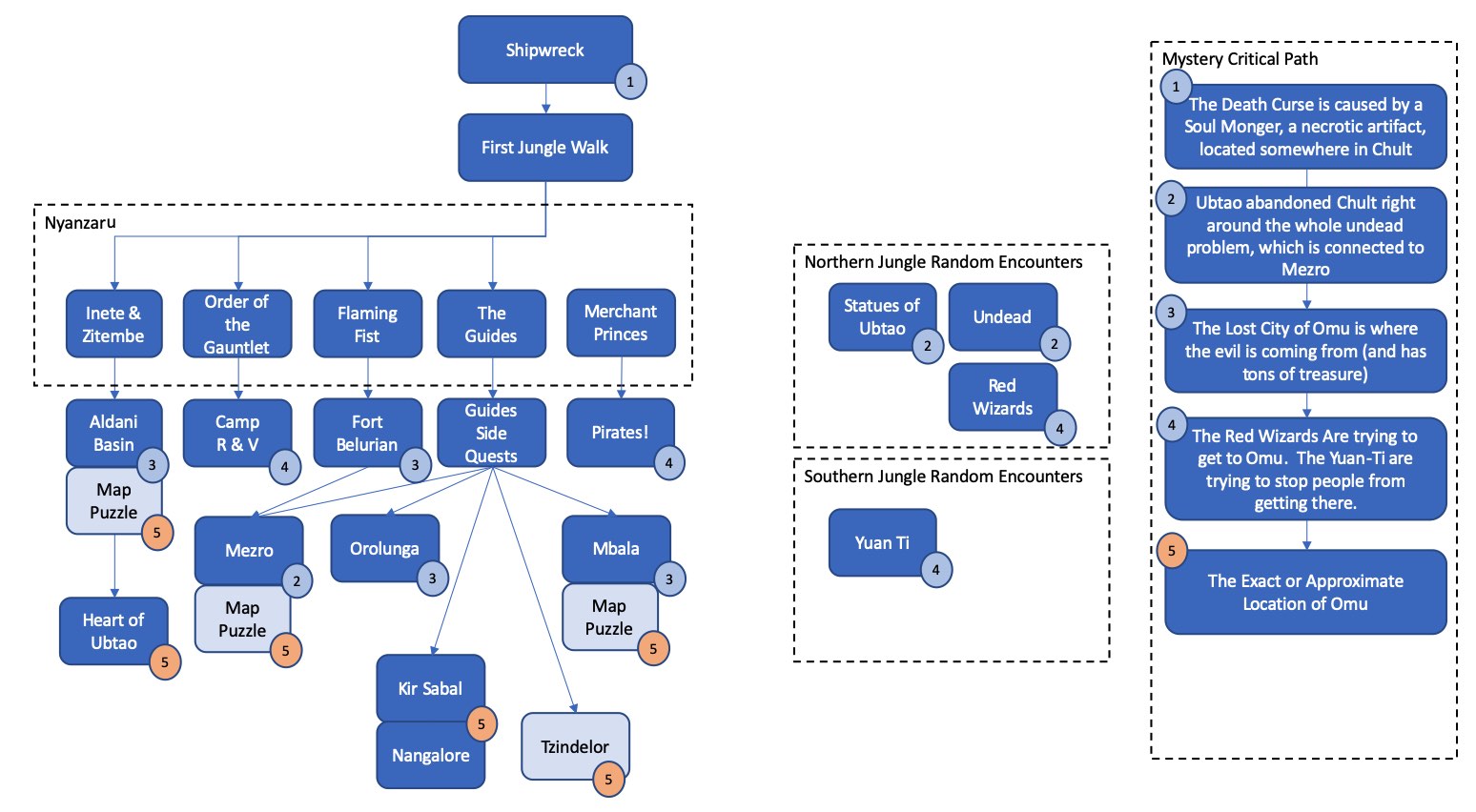
A diagram of my plan, mostly worked out before the start of Game 1
My players didn’t do half of the possible encounters, but I always kept an eye on whether or not they were still making momentum towards the goal of getting them to Chapter 3.
Map Puzzle
A fun way to drop the final clue is a puzzle that can be relocated to anywhere in the adventure where it makes sense. Once players have a clue revealing mystery path #4 the following can go just about anywhere you’d expect Omuan ruins.
Inspired by the map room in the first Indiana Jones movie, I made a puzzle the PCs could follow to get the general area where Omu is located. They knew at this point from the Sage of Orolunga that the lost city of Omu was where they were looking with the following clue:
“A wizard from the land of lakes, a survivor of 5 iterations of the universe, built a tomb in the lost city of Omu. Within it he hides the engine of undeath you seek.”
Not making it too easy, the Sage tells the party that Omu is hidden from her eyes. It’s shielded from all scrying and directions to it are removed from the memories of all living beings. They’ll have to find it through some plup archeology!
Inete has been having dreams of red wizards in the Aldani Basin. If the payers explore that they find a Red Wizard encounter with their entourage of guards and skeletons studying 4 ancient standing stones or pillars. They are marked with glyphs depicting 1. pyramid, 2. heart 3. garden and 4. Omu.
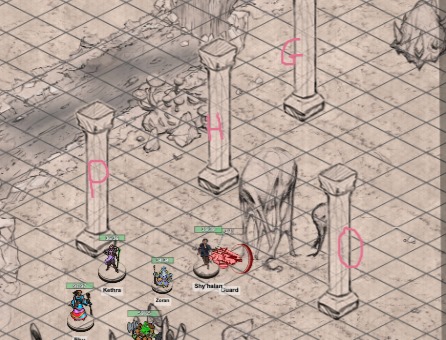
Game 5: Firefinger converted to isometric
The arrangement of the pillars reveals the approximate location of Omu as long as you can piece together from your explorations that 1 is Orolunga, 2 is the heart of Ubtao, and 3 is Nangalore. One of the pictures above is the battle map with the pillars. I copy and pasted it to the actual player’s map of Chult in Roll20 so that week to week the players could use it as a reference when guessing Omu’s location.
Just in case the players don’t pick up on this puzzle, there are books in the Heart of Ubtao, Kir Sabal, and anywhere else that is convenient that could move the story forward to Chapter 3.
The Hag problem, Alternate Mbala
D&D 5th edition over-uses hag encounters. It’s getting to the point that if there is a woman NPC in a D&D module over the age of 50, she’s more than likely part of a Hecate. Curse of Strahd, Out of the Abyss, and Descent into Avernus all have Hags.
I kept Nany Pupu but tried to make her a more sympathetic character, Pupu is tormented by a devil who used to work the tomb builder in Chapter 5 who took up residence in Mbala and slowly killed it’s population. Pupu, which isn’t the greatest name, is an immortal cleric and last survivor of Mbala. If the players remove the devil, Pupu can tell them a clue towards their quest. Pupu is a worshiper of the “lord of bones” and is still evil, I’m just underplaying the Hag aspect.
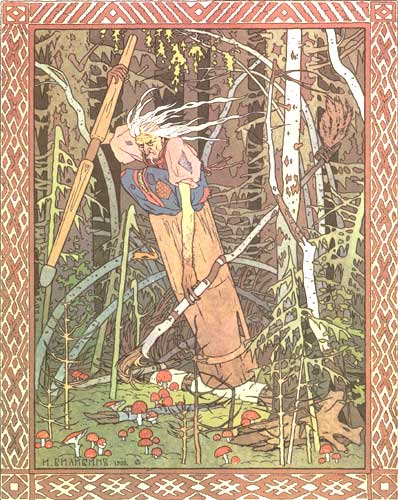
Ivan Bilibin's illustration of Baba Yaga. It's a great story from Russian fantasy.
I am pretty sure I am going to dump the additional Hag encounters in Chapter 5. I’m tired of them. I read the Baba Yaga folk story in translation in college. It was very cool, I’m just perplexed as to why they are in every single published adventure I’ve read so far.
Converting NPCs into Companions
To solve the too many NPCs in combat problem I tried using Chris Ramsely’s Companion System custom rules for 5e. I converted the various NPCs into companions, which are mechanically like items that can be attached to players that grant actions and modifiers but can also be hurt and killed. Almost like a CRPG, interacting with the companions or furthering their side quests might transform them into a more powerful form. This way, context granting NPCs with valuable information can stay attached to the expeditions into the jungle without slowing down combat or creating GM-NPCs. It isn’t perfect, but it works.
Pictures of game
I’ve mixed in screenshots of my Roll20 game above, but here are the rest. I’m looking forward to Chapter 3 through 5. I’ll at least post screenshots of what happens when they finish Chapter 3.
Continue to Part 2 of the review
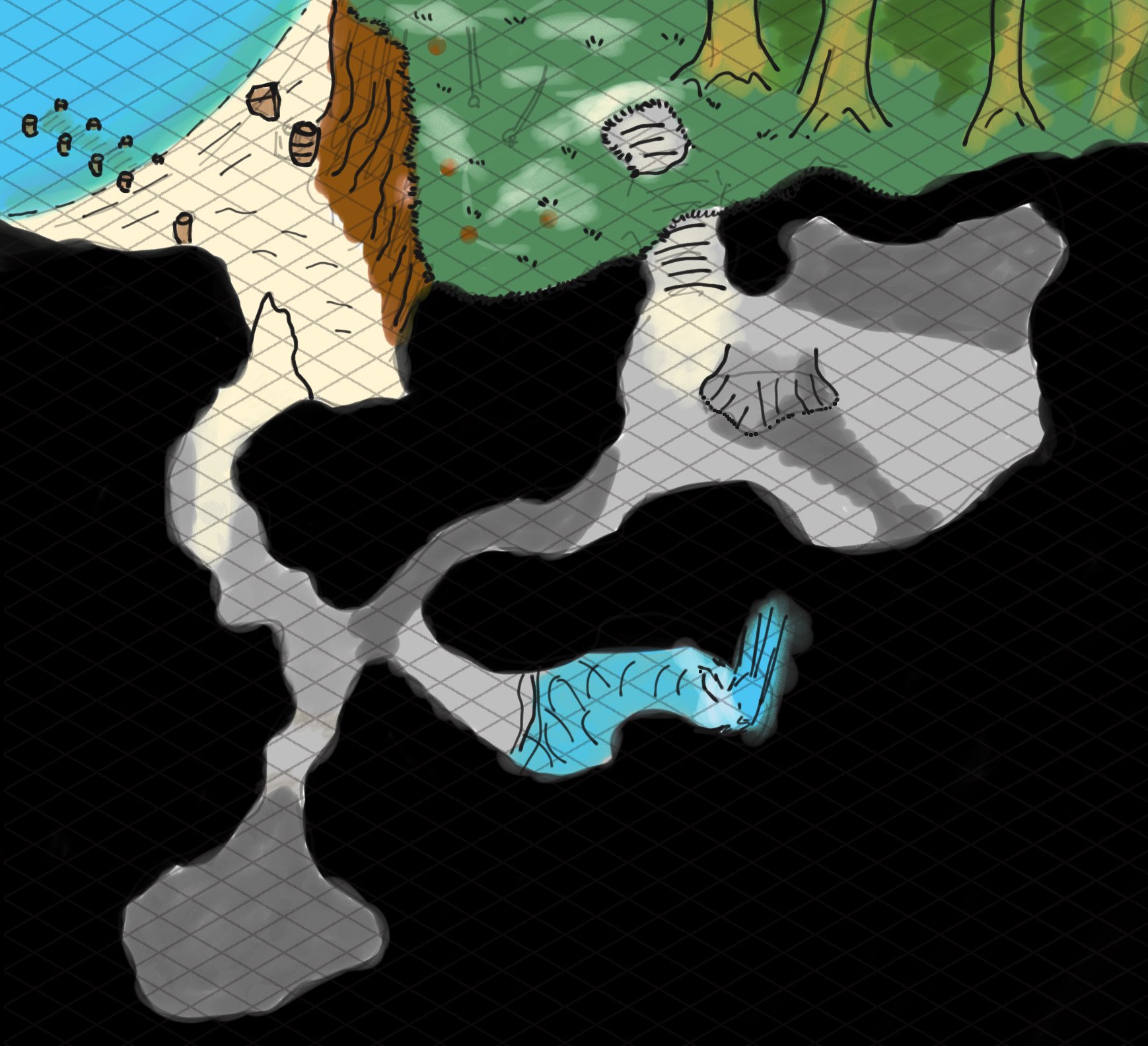
Game 1: The full Kobold Cave. First isometic map, and I learned a lot about making depth more clear
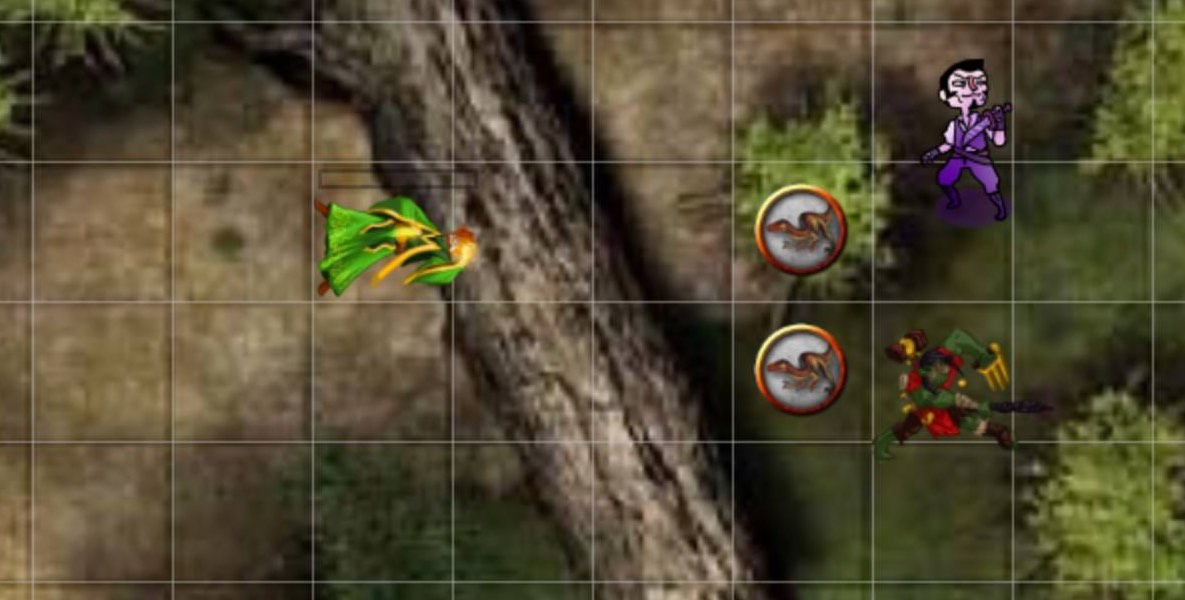
Game 2: a dangerous trek through the jungle without supplies. Trying a fight in top-down perspective.
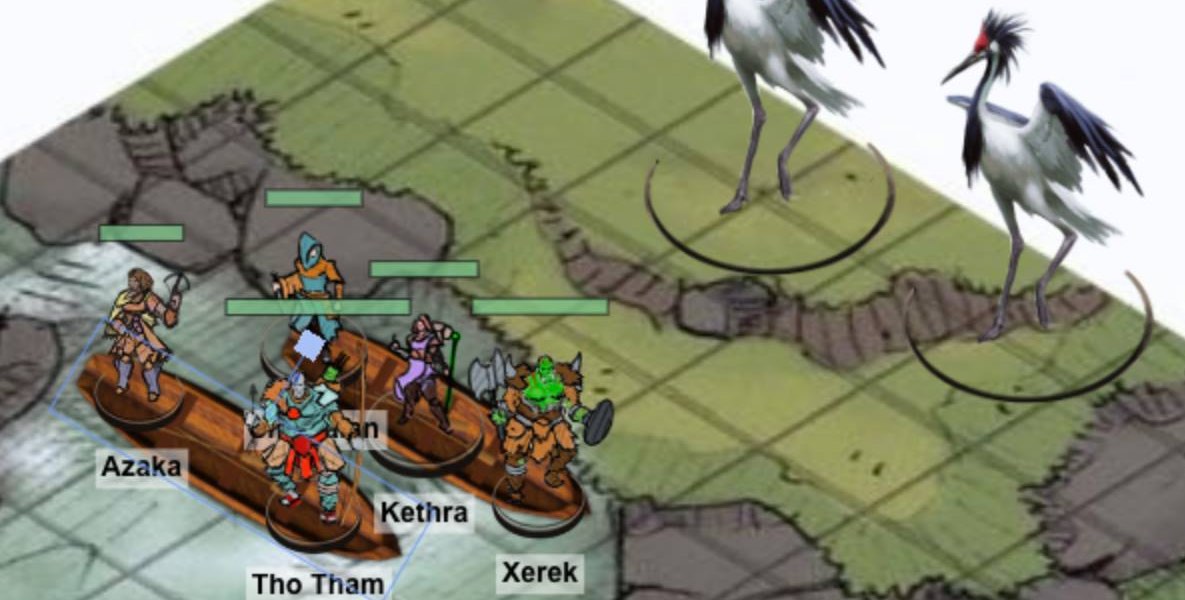
Game 4: A river trek with monsters. My game greatly improved after finding Epic Isometric.
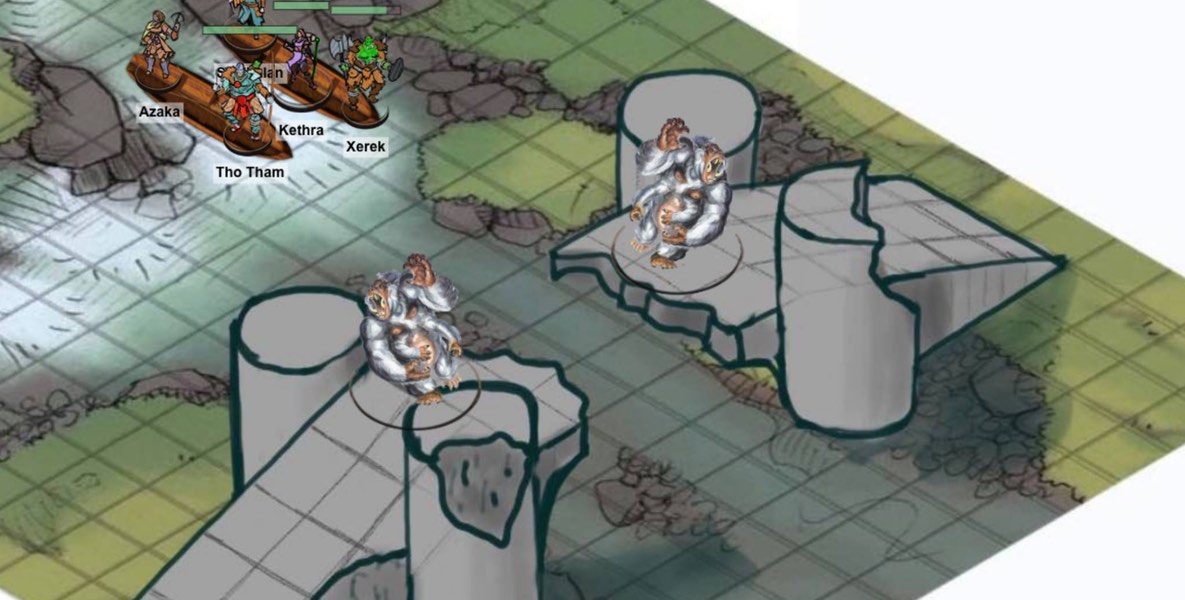
Game 4: A broken bridge with monsters. A lot of module art is close enough to isometric to turn into tokens.
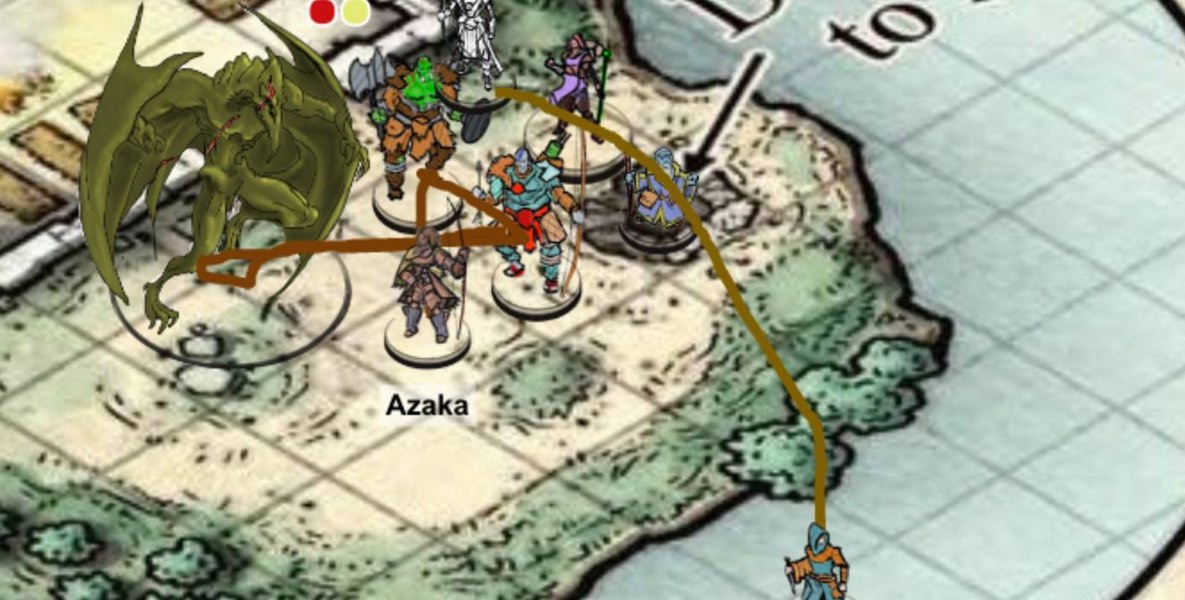
Game 5: Firefinger fight. The party smartly used climbing ropes, saving the life of the rogue.
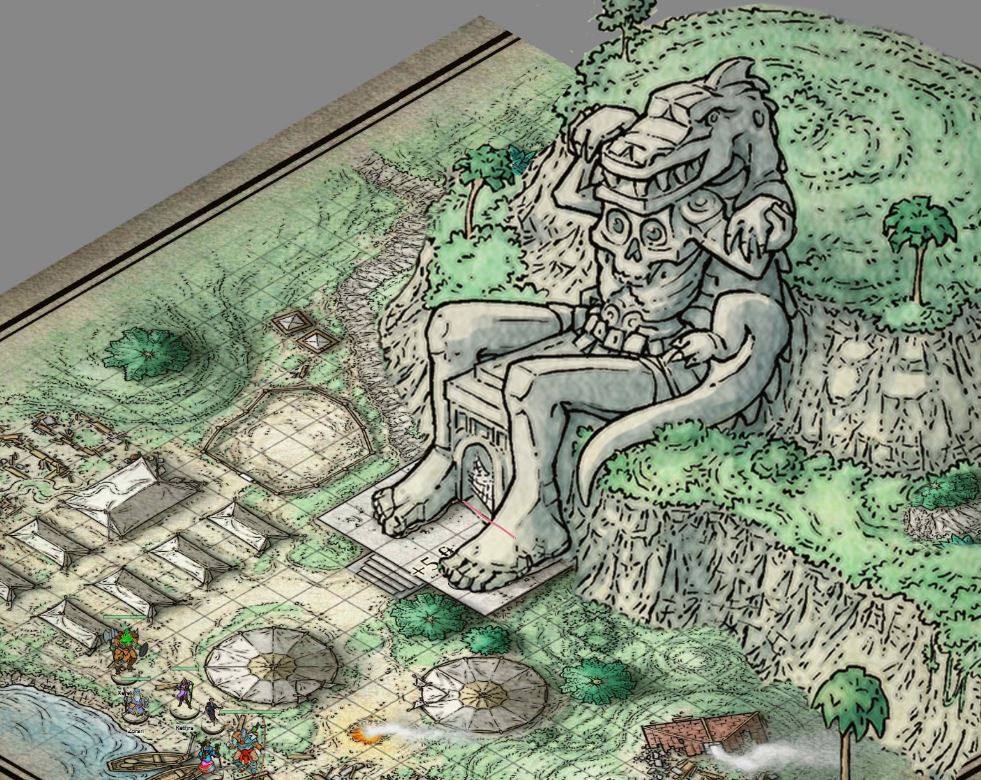
Game 8: Camp Righcheous converted to isometric. Conveniently this map comes with an isometric alternate view that is easily composited onto the rotated base map
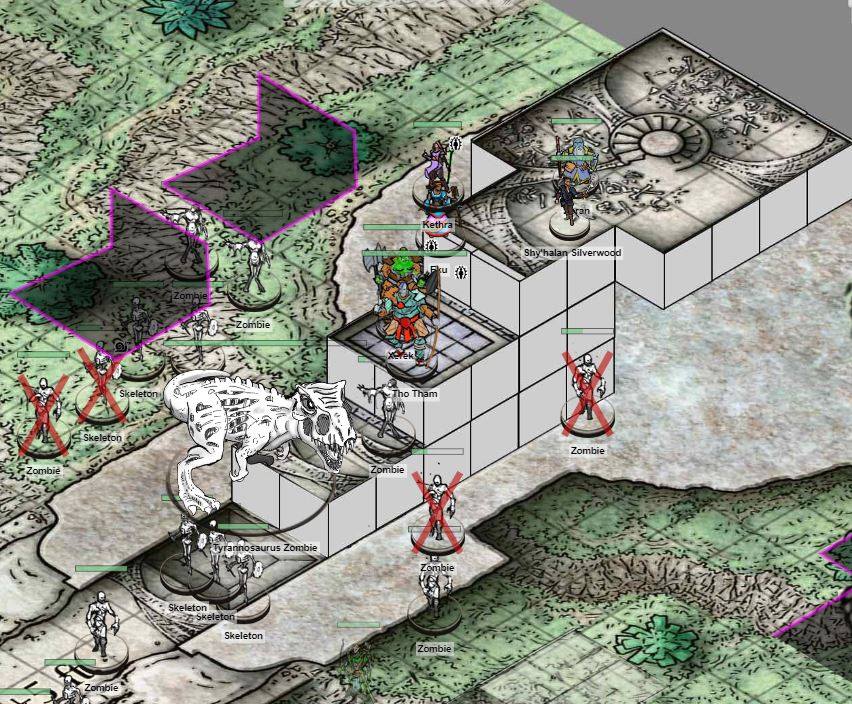
Game 9: Inside the statue! The first showstopper conversion. An unexpected Zombie T-Rex inside the Man and Crocodile statue dungeon
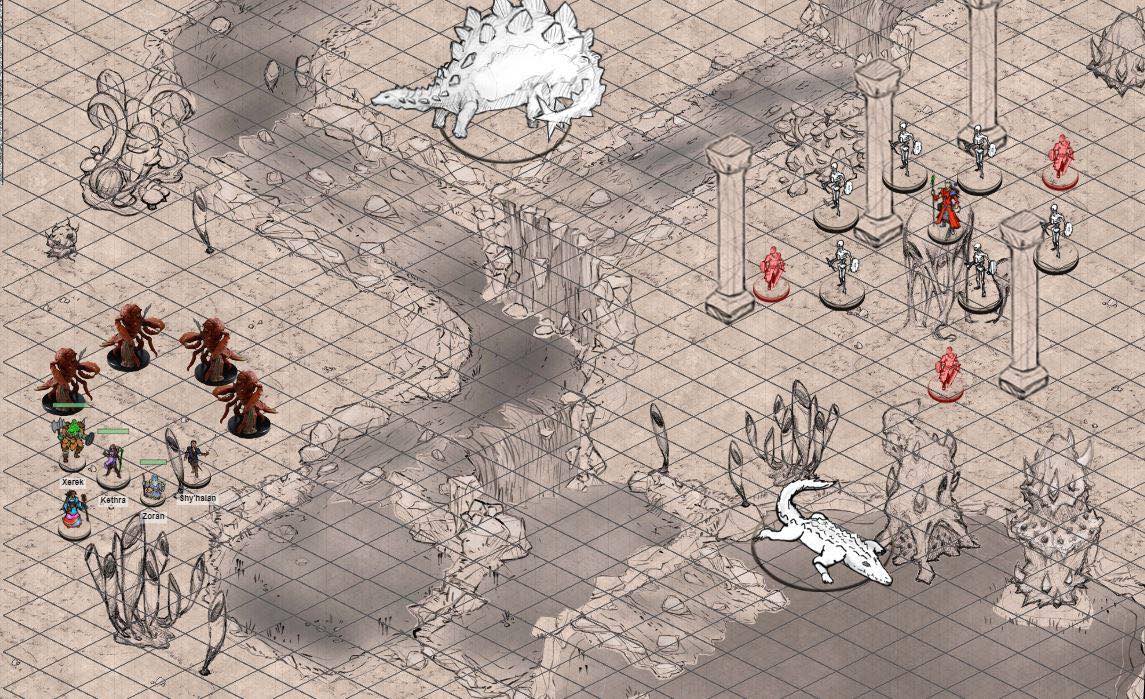
Game 12: The Aldani Basin, with a lobster rap battle and a big map clue for Omu
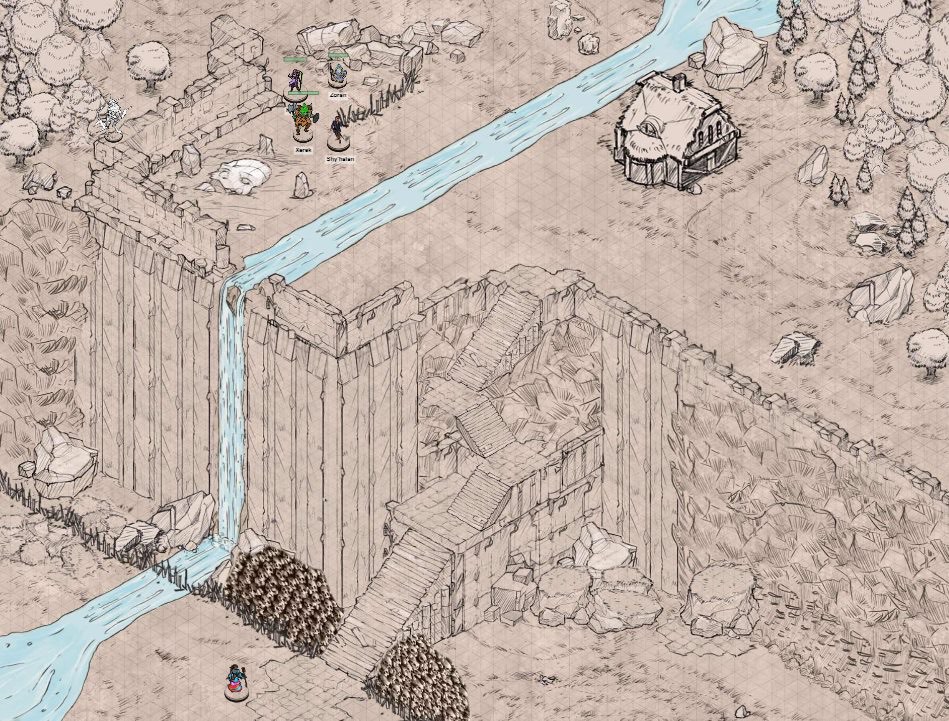
Game 13: Mbala and the devil. The base map for this one is from Epic Isometric's awesome patreon community discord server.
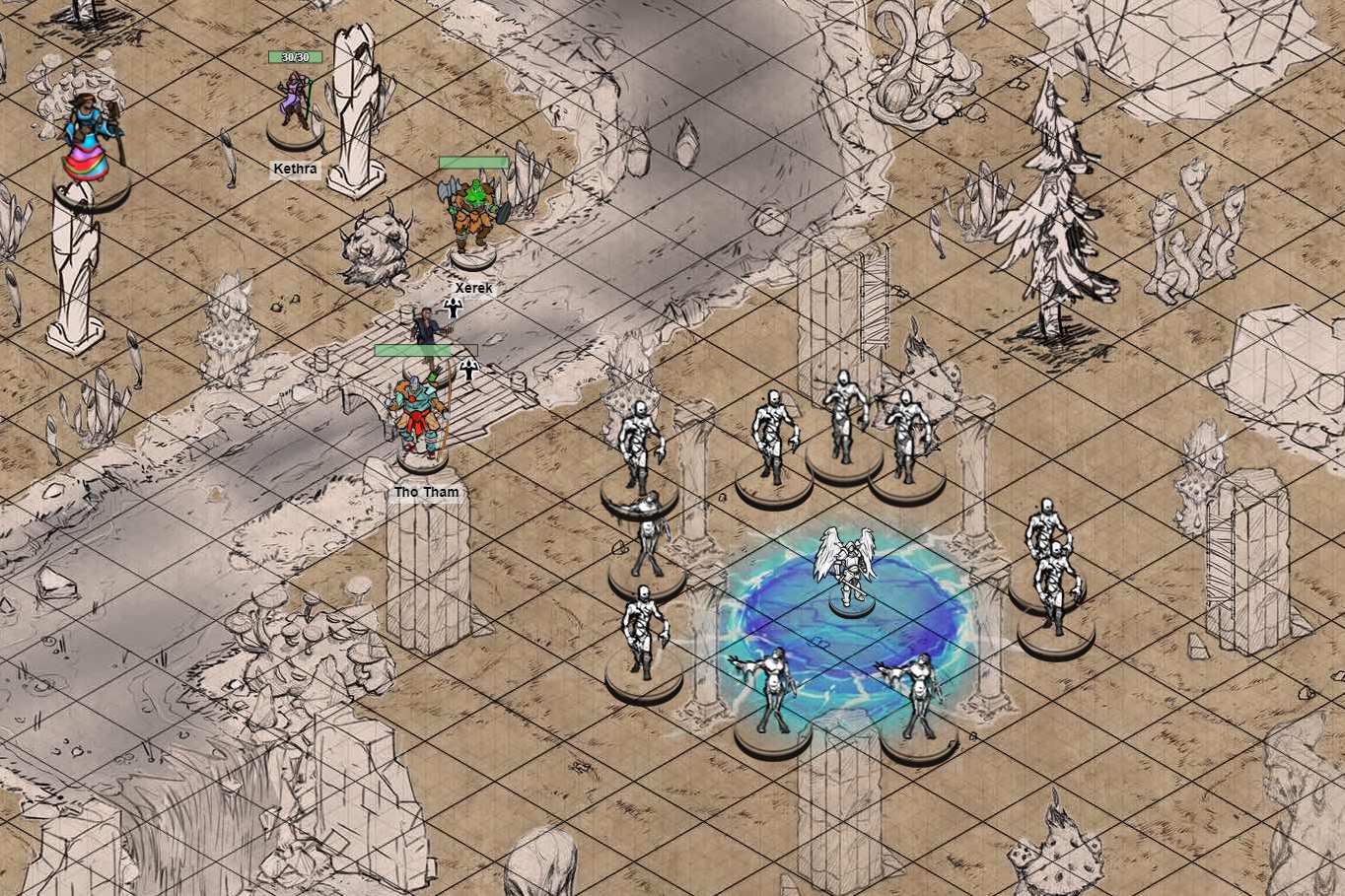
Game 14: Back in the swamp, new player introduction
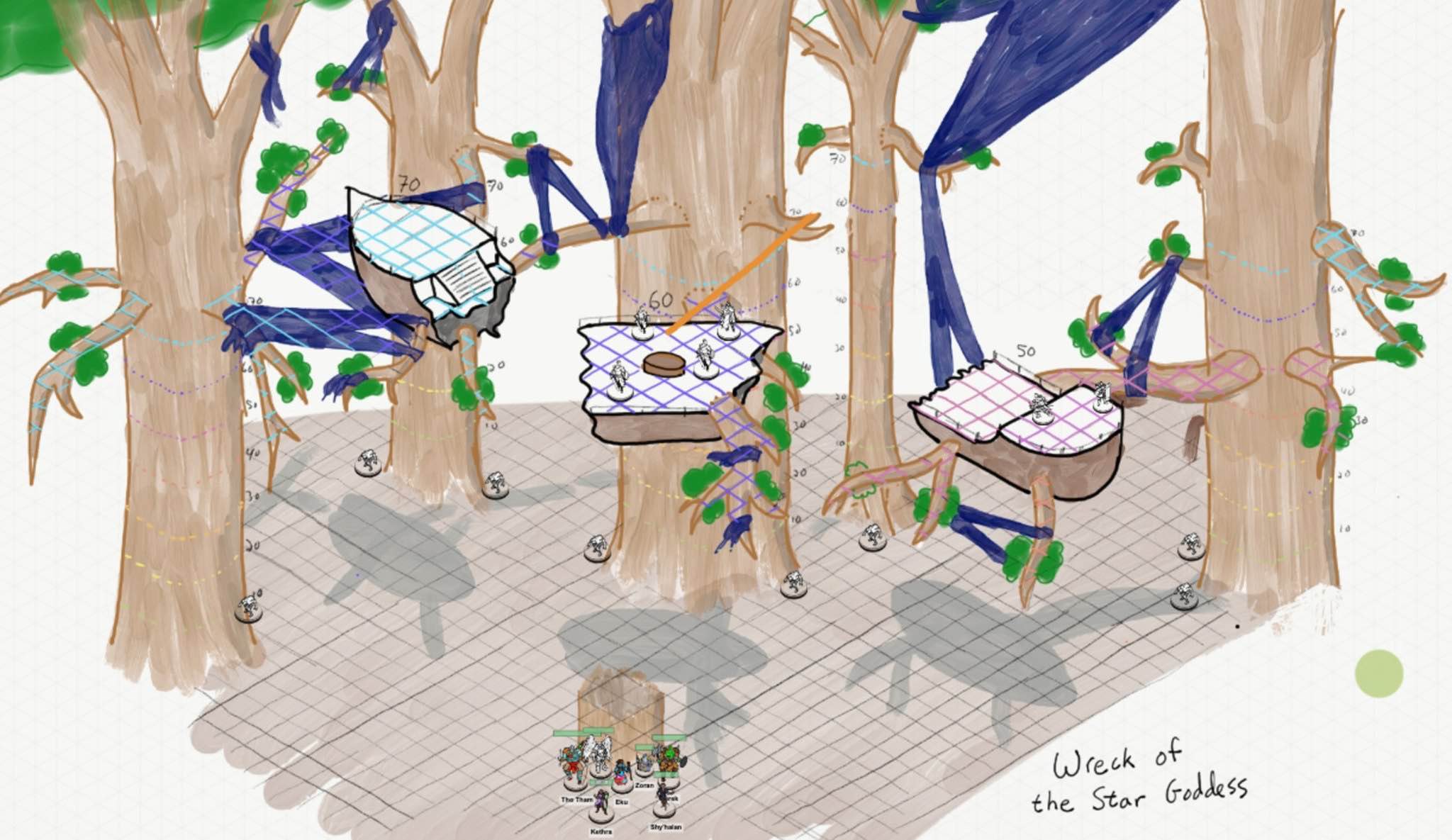
Game 15: Wreck of the Star Goddess, fully converted to isometric.
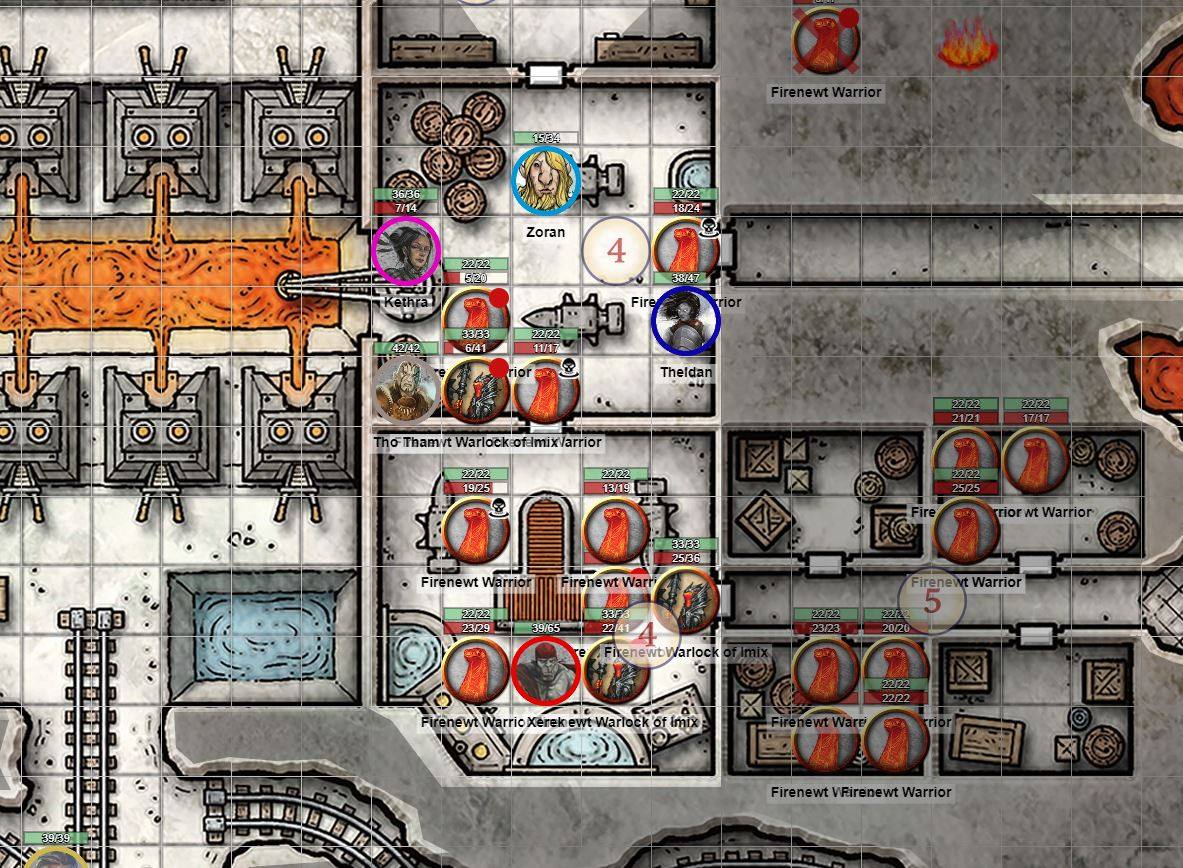
Game 17: Switching back to top-down for the Hrakhamar mine. I'm still not sure whether Iso or top-down is better for tight dungeon fights like this one.
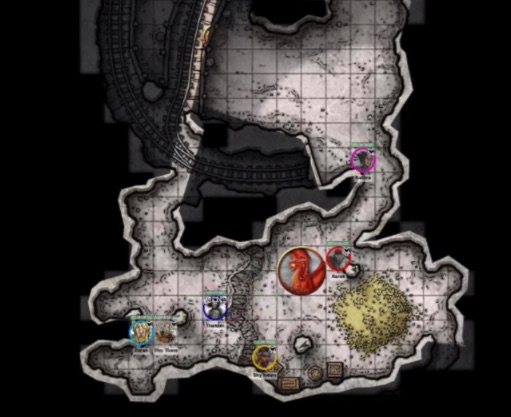
Game 19: First dragon fight in the Wyrmheart mine
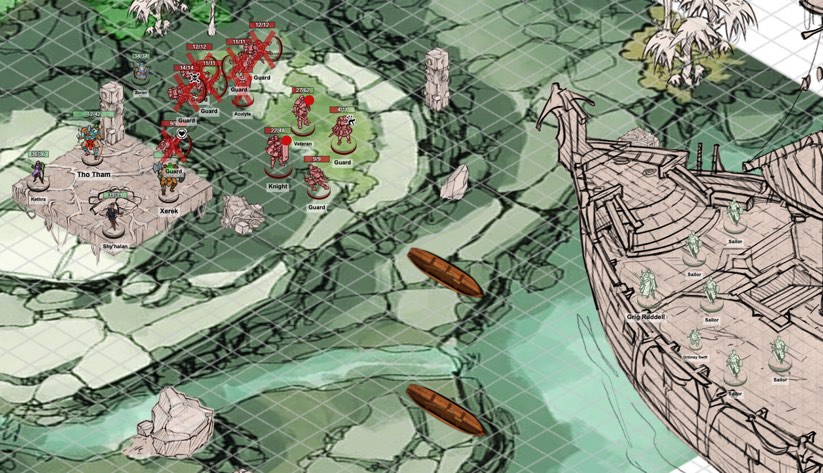
Game 20: Fighting the Flaming Fist at Shilku Bay
Thanks for reading.